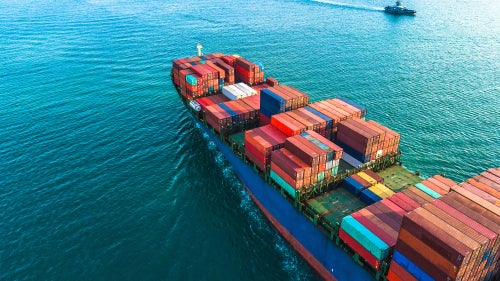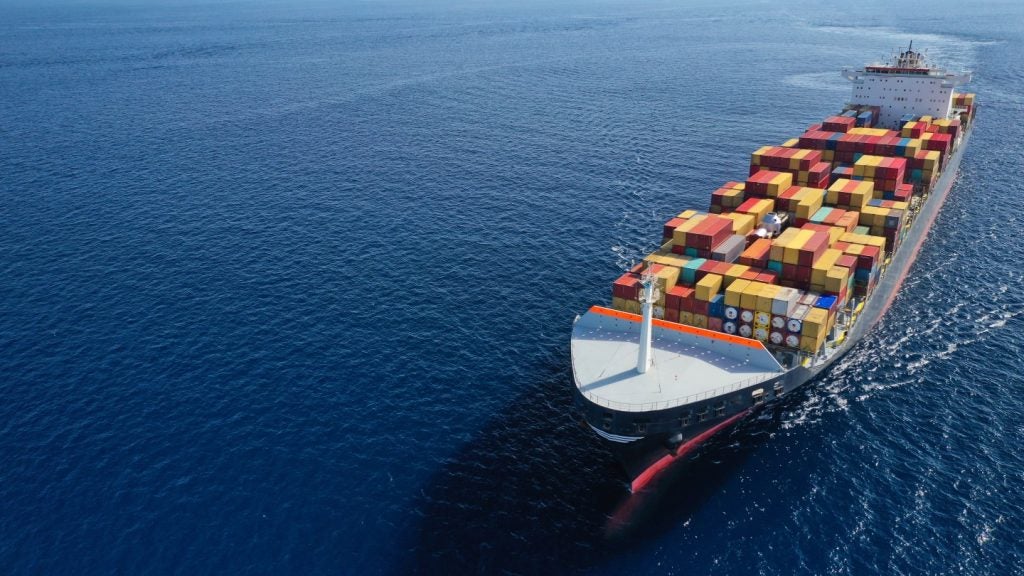
As Houthi attacks disrupt shipping in strategic chokepoints, leasing companies face uncertainties and increased risks in the wake of geopolitical tensions, writes Jeremy Weltman.
Although not directly affecting the Suez Canal, shippers passing the western coast of Yemen, more than 1,000 nautical miles south of it have become sitting targets close to the Bāb el-Mandeb Straight, a 14 nautical miles wide chokepoint through which all vessels pass to and from this important gateway.
It has become readily apparent that this area is ultimately controlled by the Shia Islamist Houthi movement, an Iran-backed rebel group in charge of large parts of southwestern Yemen as a result of that country’s deadly civil war.
The Houthi attacks are in response to Israel’s retaliation in Gaza, and while air strikes from Western navies are aiming to re-establish security, it is evidently proving to be a very challenging task.
Supply chain impact
The Suez Canal route handles approximately 12% of global trade, and up to 30% of global container shipping volume, with approximately 50 ships per day normally using this throughway to transport goods between Europe and Asia.
The US Energy Information Administration states that in the first half of 2023, 8.8m b/d of oil (both crude and refined products) went through the Bāb el-Mandeb Strait. On top of that around 8% of global LNG passes through the region, with the majority from Qatar.
How well do you really know your competitors?
Access the most comprehensive Company Profiles on the market, powered by GlobalData. Save hours of research. Gain competitive edge.

Thank you!
Your download email will arrive shortly
Not ready to buy yet? Download a free sample
We are confident about the unique quality of our Company Profiles. However, we want you to make the most beneficial decision for your business, so we offer a free sample that you can download by submitting the below form
By GlobalDataING commodities strategist Ewa Manthey Suez says sailing around the Cape saves Suez Canal fees, but it adds some 3,000-3,500 nautical miles (around 6,000 km) to the journeys between Europe and Asia. At a speed of 14 knots, this means that over 10 days, and potentially two weeks is added to the length of the trip.
“Most of the re-routed vessels carry general cargo and particularly containers. In the three weeks after mid-December, some 80% of the container vessels on the route have been forced to change course, a level which reached 90% in the first week of January,” she says.
This creates issues of course for the supply chain, not that long after the problems caused by the pandemic, and as the war in Ukraine still rages, with disruptions also being experienced currently through the Panama Canal due to extreme drought conditions pointing a finger at climate change effects. Only around 24 ships are passing daily, down from 38 normally.
Initially, the Federal Reserve Bank of New York’s Global Supply Chain Pressure Index declined in December to a level slightly below normal, contrasting with its peak levels in 2001 following the pandemic, and ING’s Manthey says there has been no fundamental impact on supply yet for oil or liquified natural gas, reflecting a substantial inventory to meet winter demand.
“Refiners and consumers could initially face some tightness as supply chains adjust to the longer route. Given the uncertainty and the risk of a spillover, oil prices are likely to remain relatively well supported,” she says, while adding: ”In order to see oil prices breaking significantly higher, we will need to see even further escalation and/or a meaningful loss in oil supply.”
As of the beginning of February this year, the OPEC basket price is around $80 a barrel, Brent at $78, and WTI crude is $72, according to oilprice.com statistics.
Rises in shipping rates and insurance fees have prompted a 15-20% jump in costs for container carriers, as major transport companies, such as CMA CGM, Evergreen, Hapag Lloyd, Maersk, MSC and Yong Ming Marine, have sensibly chosen to avoid the area altogether, or run far fewer ships. Those that are running have increased their security measures but are ostensibly still sitting targets, as the latest attack demonstrates, that being the Marlin Luanda, an oil tanker operated by the UK’s Oceonix Services.
The Freightos FBX14 container price index for the Mediterranean to China/East Asia route has shown a remarkable rise, to more than $1,288 as of the beginning of February, from $185 on December 22nd. On top of that, war risk insurance premiums have increased from 0.01% of the value of the ship in November to around 1%. This is still well below the 2-3% put on ships passing through Ukrainian waters, but it is expected to rise further.
The effects are already being felt among UK manufacturers, complaining of supply chain difficulties. The latest S&P Global UK manufacturing purchasing manufacturers’ index was not much different to earlier months. At 47.0, it remained below the critical cut-off level of 50, and was therefore still an indication of output and new orders declining. Crucially, however, the survey’s respondents noted the supply chain challenges arising from the Red Sea crisis, which is adding some 12-18 days to delivery times in certain cases.
Risk implications for leasing
As well as bumping up shipping costs, impacting on profit margins, and putting at risk the downward trend in inflation that is key to the future path of borrowing rates, these attacks are also inevitably creating issues for ship leasing.
This is especially so since sale and leaseback have become an increasingly popular option as an alternative to traditional bank loans secured by ship mortgages, and will become so especially when considering the financing of new green fleets to meet zero carbon goals. The ship leasing market was valued at $12.85 billion in 2023, according to Mordor Intelligence, and it is currently projected to increase at a compound annual growth rate of 15.1%, to almost $26 billion by 2028.
Leasing a ship is presently constrained by the availability of vessels. They are currently few and far between, with most tonnage tied into long-term leasing arrangements, as multi-year charters increased in popularity following the pandemic.
Roberto Peroni, a transportation lawyer at Reed Smith, says that as the financier is the registered owner of the asset, the enforcement risk is significantly mitigated compared with the enforcement of a traditional bank loan that may involve a lengthy arrest and judicial sale process.
“Compared with traditional bank loans, ship sale and leaseback also allow greater flexibility on the commercial terms, allowing – for instance – profit sharing arrangements, and may be more tax efficient in certain jurisdictions,” he says.
There are several players other than traditional banking groups providing the ship sale and leaseback service. As a result, in the past few years, this type of ship financing has proven a significantly competitive source of finance. The providers of finance tend to be investment funds, shipping companies, or time charterers, but this is not a standardised market, with most arrangements tending to be on bespoke terms.
Peroni says that investment funds started investing in the shipping industry over a decade ago and they remain an important alternative source of capital for the industry. Investment funds may either fund a majority, or minority stake in the vessel-owning company and generally expect preferred shares to ensure an attractive return on the investment.
“This kind of arrangement generally involves multiple vessels and requires a strong management platform. As in these structures financiers underwrite the equity, the return on their investment tends to be higher than for leasing or bank lending,” says Peroni. He goes on to mention that when the vessel is placed on a long charter, owners may offer time charterers the opportunity to co-invest in the ship and return the investment over the life of the time charter.
“Historically, shipping companies have shared ownership risk with other shipping companies under joint venture arrangements. These arrangements used to be very common in the shipping industry and various shipping players have been joining forces to counter the present increase of the interest rates.”
War risks
According to Peroni, shipping lessors tend to have minimal involvement in the commercial operations of the vessel and therefore undertake minimal risk in connection with vessel operational issues, including safety and war risks. Lessees, meanwhile, are required to operate the vessel following best ship management practices and to procure compliance with insurance and regulatory requirements.
“Under common ship leasing terms, lessor’s consent and additional insurance coverage is required when the vessel passes via areas that are exposed to ‘War Risks’ – defined as wars, hostilities, acts of piracy, acts of terrorism, or similar events that may be dangerous, or are likely to be dangerous to the vessel, her crew and cargo,” he says.
“The definition of War Risks is generally very broad, but some circumstances where there are no declared wars or major operations may be open to interpretation.”
He goes on to mention that in more recent deals, shipping lessors’ financing vessels tend to clarify the point further and restrict employment of the vessel in specific risky areas where an additional war risk premium is payable, for example in the Black Sea, Red Sea or other areas from time to time that are considered at risk. This may result, he says, in greater reporting requirements to lessors when the vessel passes such areas and the option for the lessor to impose more stringent safety and insurance requirements to allow it.
“In such cases, the decision to employ a vessel in high-risk waters is up to the lessee, who may also have the option to increase the insurance cover. Where permitted under the relevant charter parties, lessees may share part of the additional costs and risk with time charterers.
“As lessors charter vessels on ‘hell and high water’ terms, the lessee remains liable to pay hire to the lessor even where the vessel is prevented from trading due to attacks, hijacking or similar risks, in addition to indemnification of the lessor.”
If the vessel is hijacked and not released for over 6-12 months, depending on the relevant insurance policy terms, it may be deemed a total loss, and the insurance proceeds (depending upon the market value of the vessel and the terms of the lease) are first used to repay the lessor. Until the agreed indemnity amount is paid, the lessee may be required to keep paying hire to the lessor.
According to Peroni, the recent attacks in the Red Sea increase the operational risks for shipping companies and therefore shipowner lessees interested in transiting the area despite the current crisis should be prepared to manage relevant additional risks. Such risk may be rewarded by higher freight rates, noting that the number of vessels passing the Red Sea is drastically reduced due to the increased risks.
“We do not see a present impact of the Red Sea crisis on lessors entering into/not entering into leases, save that lessors may revisit their standard provisions as they relate to vessel employment and insurance (or decline to deviate from their more stringent standard requirements).
“For existing lease deals, lessors will be concerned as to the preservation of the value of the owned asset and the maintenance of adequate insurance covering the vessel’s areas of operation, together with ongoing prudence of the lessee. This will include ongoing monitoring of compliance with lease undertakings.”
It is difficult to make accurate predictions as to how the Red Sea crisis will evolve, but it has clearly become a major focal point of Middle East instability at a time when supply chain constraints have occurred also due to the war in Ukraine, causing the supply of commodities to virtually disappear from the Black Sea to the rest of the world. This was key in several sectors, such as grain, fertilisers, metals, gas and oil.
Those now looking to avoid any high-risk waters may be forced to avoid passage via the Red Sea, the Black Sea and the Levantine Sea, and to accept sailing passage via the Cape of Good Hope, possibly for an indefinite period. This scenario may divide the shipping community between owners with a lower risk appetite and those who will agree to take on that risk, likely in exchange for higher freight/hire rates.
The leasing industry will be monitoring the situation closely, and the coming months will provide a better indication if this has resulted in any actual impact on the hire rates.
Red Sea disruptions challenge global shipping and supply chain finance







